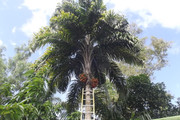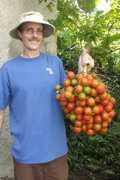About spineless peach palm, its productivity and oil content:
Iíve grown peach palms here in Haiti since 2009. I bought ďspinelessĒ seeds that year from RarePalmSeeds.com and most grew spineless. Several more orders from RarePalmSeeds and other sources usually didnít germinate. The original trees were growing so well and I couldnít find a reliable source of seed so in 2014 I went to Costa Rica to get a good genetic diversity of seed. I have about 520 planted out on about 3 acres. The goal is to get a good source of seeds and seedlings to distribute in Haiti for development, food security, and helping our mission churches.
Last year many of the original trees started fruiting. Most of the thornless fruits are similar and low oil, but one is highly productive and oily. Over 100 pounds of fruit the past 12 months, I guess about 120 pounds. 8 or 9 bunches, heaviest was 24 pounds. Some of the trees set seedless fruits and others drop all their immature fruit if they donít get pollinated. Pollination is an issue here, we donít have the beetles that do most of the pollination in the native range. Pollen drops about an hour before sunset and bees sometimes visit the blooms but nothing like the interest they have for royal palms and coconuts. With about 8 blooming trees, and our two bloom periods per year, there isnít much bloom overlap for pollination, I have had to save pollen and hand pollinate to get good bunches of seeded fruit.


I also have a few wild type, probably B. setulosa with small red fruit, hardly any pulp, not good eating, Iím pretty sure they set seeded fruit without other bactris blooming. They are spineless when small, but get very spiney all over when they grow a trunk.
2014 & 2015 were years of drought in Costa Rica and Haiti. Here are photos I took at CATIE. Their thornless peach palms looked as productive as the thorny ones. I was told that the thornless are usually low-oil. The people there prefer fruits with seeds because seedless is low oil. There was an extremely oily thornless peach palm that wasnít very good because of fibers in the fruit. Another had fruit almost at ground level.


Some of my plants are from fruits at a big tourist stop market near Squirres, Costa Rica. At least 3 of the thornless peach palm seedlings from Costa Rica are turning spiney now that they are getting trunks. At least the spines are short but it is a problem when planted where thorns are a danger like by a path in a public area. I wonder if it is a setulosa or other hybrid that may have an advantage at higher elevations.

The young trees have really done best where there is some shade, usually from larger nearby trees but this may be due to the dry weather the first year after they were planted. They tend to get stunted and yellow in full sun, whether in the ground or in the nursery.
Peach palm tend to grow much faster than acai here. I have had close to 100 percent survival in the field despite many being attacked by goats, cows, white grubs and rhino beetles. They just put up a new sucker if any of the base is left intact. If a beetle eats the heart it usually results in two or more plants coming up, which can be divided for propagation. A person experienced digging banana pups with a digging bar can have good results removing good size offshoots for propagation.





